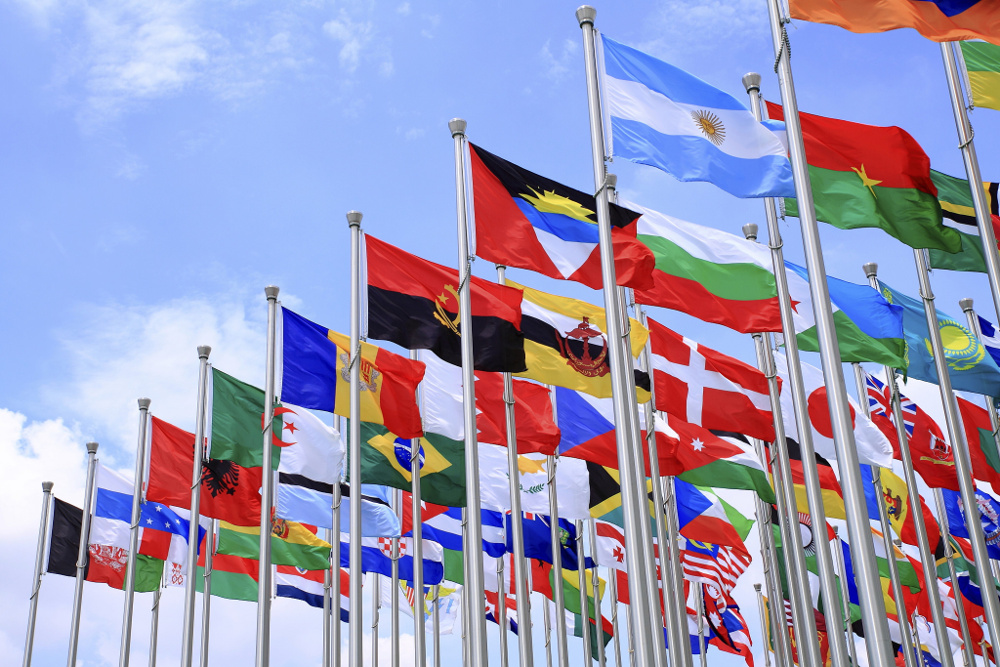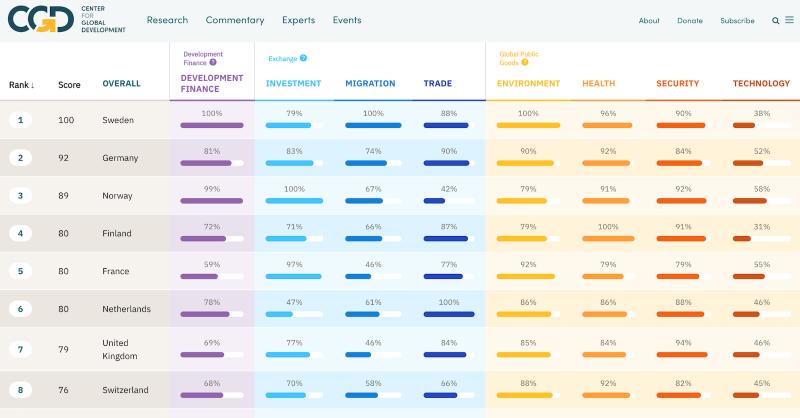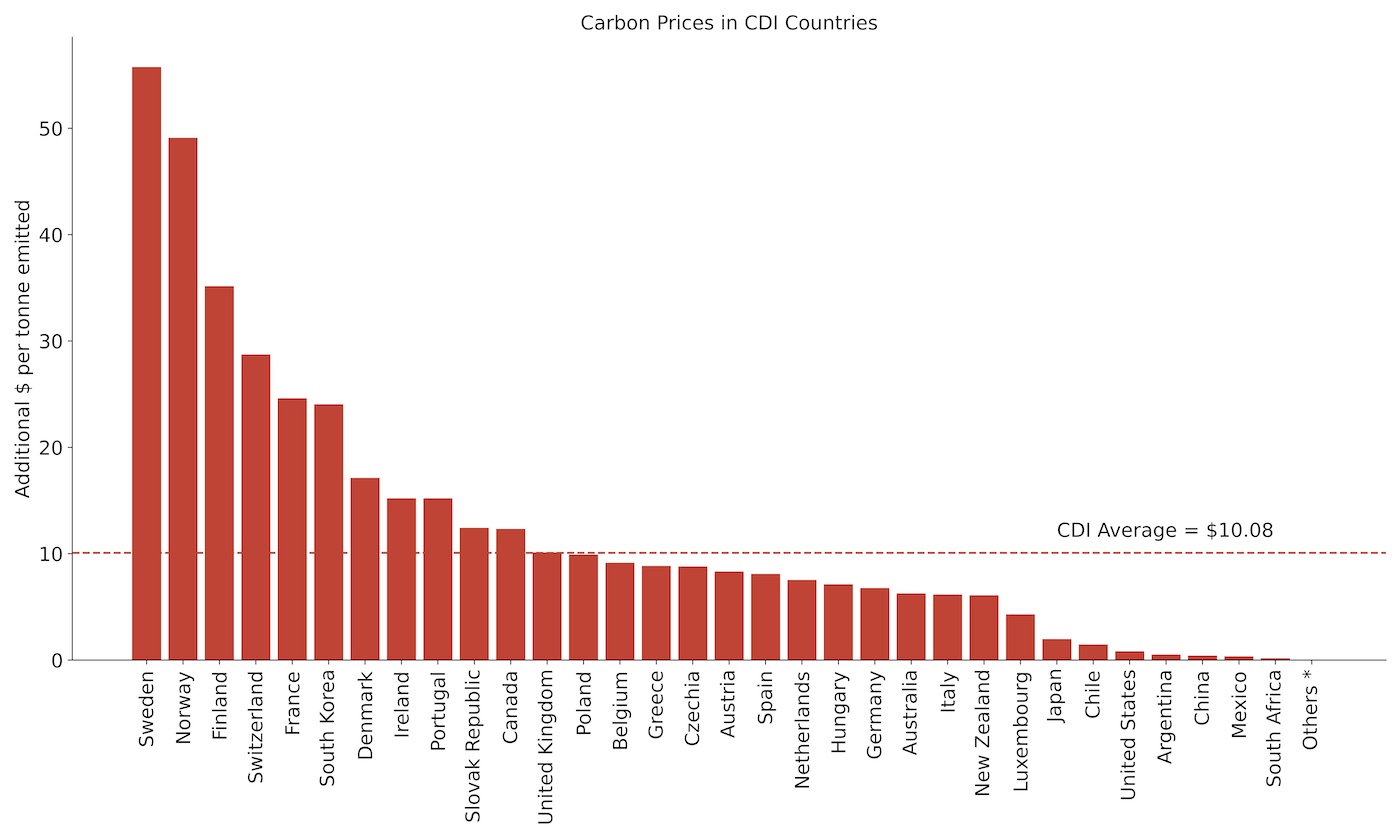November 01, 2011
This post is coauthored with Julia Clark.Each year since 2003, the Center for Global Development has "ranked the rich"---assessing which wealthy nations do the most (for their size) to bring good government and prosperity to the rest of the world. Today, we released the 9th edition of this assessment, the 2011 Commitment to Development Index. The core idea of the CDI is that nations are linked in many ways: through foreign aid, trade and investment flows, movement of people, natural resources, military affairs, technology. Governments, through their policies and actions, influence these linkages for good and ill. In particular, helping poorer nations takes more than aid. Of course, government policies and actions don't usually change much from year to year. So the top (and bottom) countries on the new ranking should look familiar. Sweden, Norway, Denmark, and the Netherlands take the top four spots while South Korea and Japan come last. The high scores of the top four owe above all to their generous aid giving. The high standings of Sweden and Norway also derive from their openness to immigrants from developing countries, including refugees.The map-based data explorer on the CDI site makes it easy to detect these and other patterns, and drill into the details. From that page, you can also find background reports, three-page assessments for each country, spreadsheets, and more.Among the biggest movers this year:
Of course, government policies and actions don't usually change much from year to year. So the top (and bottom) countries on the new ranking should look familiar. Sweden, Norway, Denmark, and the Netherlands take the top four spots while South Korea and Japan come last. The high scores of the top four owe above all to their generous aid giving. The high standings of Sweden and Norway also derive from their openness to immigrants from developing countries, including refugees.The map-based data explorer on the CDI site makes it easy to detect these and other patterns, and drill into the details. From that page, you can also find background reports, three-page assessments for each country, spreadsheets, and more.Among the biggest movers this year:
 Of course, government policies and actions don't usually change much from year to year. So the top (and bottom) countries on the new ranking should look familiar. Sweden, Norway, Denmark, and the Netherlands take the top four spots while South Korea and Japan come last. The high scores of the top four owe above all to their generous aid giving. The high standings of Sweden and Norway also derive from their openness to immigrants from developing countries, including refugees.The map-based data explorer on the CDI site makes it easy to detect these and other patterns, and drill into the details. From that page, you can also find background reports, three-page assessments for each country, spreadsheets, and more.Among the biggest movers this year:
Of course, government policies and actions don't usually change much from year to year. So the top (and bottom) countries on the new ranking should look familiar. Sweden, Norway, Denmark, and the Netherlands take the top four spots while South Korea and Japan come last. The high scores of the top four owe above all to their generous aid giving. The high standings of Sweden and Norway also derive from their openness to immigrants from developing countries, including refugees.The map-based data explorer on the CDI site makes it easy to detect these and other patterns, and drill into the details. From that page, you can also find background reports, three-page assessments for each country, spreadsheets, and more.Among the biggest movers this year:- Switzerland (score: +0.6, rank +2). Using 2011 methodology, which is just a tad different from 2010's, Switzerland improved its score from 4.5 to 5.1, climbing from 20th to 18th. It benefitted from a substantial increase in its inflow of legal migrants, largely from Sub-Saharan Africa and Latin America. Its score on the environment component also improved, in part because of lower greenhouse gas emissions.
- Finland (score: +0.4, rank +1). Finland’s score increased from 5.7 to 6.1, raising its rank to 6 from 7 the previous year (again, using 2011 methodology). This change is largely a result of improvements to its aid, environment and technology scores, which rose following a 0.11% increase in net aid/GDP, reduced emissions growth and tropical woods imports, and a bump in government R&D expenditure.
- The United States (score: +0.7, rank +2), which achieved 5th place, up from 7th last year and 17th in 2009. Why the big jump since Obama took office? Did his administration send more aid to well-governed countries, lower its tariffs on sugar imports, or ratify the Kyoto Protocol? Not so much. But it posted 65,000 more troops to Afghanistan (31,700 posted at the end of 2008; 97,000 at the end of 2010.) The CDI rewards participating in peacekeeping and military interventions as long as they have a mandate from an appropriate international organization. The U.N. Security Council endorses the military operations in Afghanistan. If that raises your eyebrows, read on.
- We revised the measure of imports from developing countries. Before, it gave double weight to imports from least developed countries, and double weight to manufactures, thus quadruple weight to manufactures from LDCs. Now it rewards imports of manufactures only, using weights that vary smoothly with the exporter's GDP/capita. This brings the trade component into conformity with the aid and migration components, which also use a sliding scale to give the greatest reward to aid given to the poorest countries and immigration received from them.
- We posted the main CDI database (go to Inside the Index). This brings the CDI project into much better compliance with CGD's new data and code transparency policy. This step was made possible by the World Bank's turn toward data openness. The CDI database contains a copy of the Bank's World Development Indicators, which we used to have to buy, and could not share. Now that the WDI database is freely available, most of the CDI database can be too. The one exception, for now, is that we cannot post our copy of CEPII's MAcMap database on trade barriers, which is the foundation for most of the trade component. Otherwise, if you have technical savvy (you need to know your way around Microsoft SQL Server), you can now replicate and scrutinize all the calculations in the CDI.
- We added an ability to link to specific views in the data explorer. Now you can share direct links to the environment component or Australia's results with all your friends on Facebook and Twitter. We know you're excited.
Disclaimer
CGD blog posts reflect the views of the authors, drawing on prior research and experience in their areas of expertise. CGD is a nonpartisan, independent organization and does not take institutional positions.





